|
Greetings, The Southwest Museum of Engineering,
Communication and Computation is seeking :
artifacts, books, papers, personal recollections, funny stories,
newspaper clipping, magazines, catalogs, articles torn out of
magazines, cartoons, prototype magnetrons, really early
microwave ovens etc ANYTHING Is Fair Game!
The purpose is two-fold which consists of construction the display in the
museum in Glendale Arizona and also as an addition to our web site.
thanks Ed Sharpe archivist for SMECC
Please check our web site at
http://www.smecc.org
to see other engineering fields, communications and computation stuff we
buy, and by all means when in Arizona drop in and see us.
address:
coury house / smecc
5802 w palmaire ave
glendale az 85301
thanks Ed Sharpe archivist for SMECC
|
| The microwave oven was invented as an
accidental by-product of war-time (World War 2) radar research using
magnetrons (vacuum tubes that produce microwave radiation, a type of
electromagnetic radiation that has a wavelength between 1 mm and 30 cm).
In 1946, the engineer Dr. Percy LeBaron Spencer, who
worked for the Raytheon Corporation, was working on magnetrons. One day at
work, he had a candy bar in his pocket, and found that it had melted. He
realized that the microwaves he was working with had caused it to melt.
After experimenting, he realized that microwaves would cook foods quickly
- even faster than conventional ovens that cook with heat.
The Raytheon Corporation produced the first commercial
microwave oven in 1954; it was called the 1161 Radarange. It was large,
expensive, and had a power of 1600 watts. The first domestic microwave
oven was produced in 1967 by Amana (a division of Raytheon).
In 1967, Amana, a division of Raytheon, introduced its
domestic Radarange microwave oven, marking the beginning of the use of
microwave ovens in home kitchens. Although sales were slow during the
first few years, partially due to the oven’s relatively expensive price
tag, the concept of quick microwave cooking had arrived. In succeeding
years, Litton and a number of other companies joined the countertop
microwave oven market. By the end of 1971, the price of countertop units
began to decrease and their capabilities were expanded.
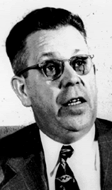
Spencer, born in Howland, Maine, was orphaned at a
young age. Although he never graduated from grammar school, he became
Senior Vice President and a member of the Board of Directors at Raytheon,
receiving 150 patents during his career. Because of his accomplishments,
Spencer was awarded the Distinguished Service Medal by the U.S. Navy and
has a building named after him at Raytheon.
Percy Spencer, while working for the Raytheon
Company, discovered a more efficient way to manufacture magnetrons. In
1941, magnetrons were being produced at a rate of 17 per day. Spencer set
out to create a simpler magnetron that could be mass produced. The result
was a magnetron that replaced precision copper bars with lamina and
replaced soldered internal wires with a simple solid ring. These
improvements and others allowed for the faster production of 2,600
magnetrons per day.
In 1945, Spencer created a device to cook food using
microwave radiation. Raytheon saw the possibilities of this, and after
acquiring Amana Refrigeration in 1965, was able to sell microwave ovens on
a large scale. The first microwave oven was called the Radarange, and
today, there are over 200 million in use throughout the world.
|
A Brief
History of the Microwave Oven
By J.
Carlton Gallawa, author of THE
COMPLETE MICROWAVE OVEN SERVICE HANDBOOK
 Like
many of today's great inventions, the microwave oven was a by-product of
another technology. It was during a radar-related Like
many of today's great inventions, the microwave oven was a by-product of
another technology. It was during a radar-related  research
project around 1946 that Dr. Percy Spencer, a self-taught engineer with
the Raytheon Corporation, noticed something very unusual. He was testing a
new vacuum tube called a magnetron
(we are searching for a picture of an actual 1946 magnetron), when he
discovered that the candy bar in his pocket had melted. This intrigued Dr.
Spencer, so he tried another experiment. This time he placed some popcorn
kernels near the tube and, perhaps standing a little farther away, he
watched with an inventive sparkle in his eye as the popcorn sputtered,
cracked and popped all over his lab. research
project around 1946 that Dr. Percy Spencer, a self-taught engineer with
the Raytheon Corporation, noticed something very unusual. He was testing a
new vacuum tube called a magnetron
(we are searching for a picture of an actual 1946 magnetron), when he
discovered that the candy bar in his pocket had melted. This intrigued Dr.
Spencer, so he tried another experiment. This time he placed some popcorn
kernels near the tube and, perhaps standing a little farther away, he
watched with an inventive sparkle in his eye as the popcorn sputtered,
cracked and popped all over his lab.
The next morning, Scientist
Spencer decided 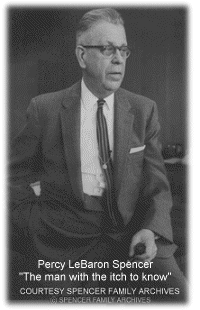 to
put the magnetron tube near an egg. Spencer was joined by a curious
colleague, and they both watched as the egg began to tremor and quake. The
rapid temperature rise within the egg was causing tremendous internal
pressure. Evidently the curious colleague moved in for a closer look just
as the egg exploded and splattered hot yoke all over his amazed face. The
face of Spencer lit up with a logical scientific conclusion: the melted
candy bar, the popcorn, and now the exploding egg, were all attributable
to exposure to low-density microwave energy. Thus, if an egg can be cooked
that quickly, why not other foods? Experimentation began... to
put the magnetron tube near an egg. Spencer was joined by a curious
colleague, and they both watched as the egg began to tremor and quake. The
rapid temperature rise within the egg was causing tremendous internal
pressure. Evidently the curious colleague moved in for a closer look just
as the egg exploded and splattered hot yoke all over his amazed face. The
face of Spencer lit up with a logical scientific conclusion: the melted
candy bar, the popcorn, and now the exploding egg, were all attributable
to exposure to low-density microwave energy. Thus, if an egg can be cooked
that quickly, why not other foods? Experimentation began...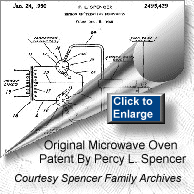
Dr. Spencer fashioned a metal box
with an opening into which he fed microwave power. The energy entering the
box was unable to escape, thereby creating a higher density
electromagnetic field. When food was placed in the box and microwave
energy fed in, the temperature of the food rose very rapidly. Dr. Spencer
had invented what was to revolutionize cooking, and form the basis of a
multimillion dollar industry, the microwave oven.
(Click HERE
to learn even more about Dr. Percy Spencer)
Nearly 6 Feet Tall, Weighing 750 Pounds
Engineers went to work on
Spencer's hot new idea, developing and refining it for practical use. By
late 1946, the Raytheon Company had filed a patent proposing that
microwaves be used to cook food. An oven that heated food using microwave
energy was then placed in a Boston restaurant for testing. At last, in
1947, the first commercial microwave oven hit the market. T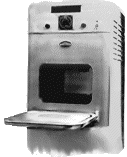 hese
primitive units where gigantic and enormously expensive, standing 5 1/2
feet tall, weighing over 750 pounds, and costing about $5000 each. The
magnetron tube had to be water-cooled, so plumbing installations were also
required. hese
primitive units where gigantic and enormously expensive, standing 5 1/2
feet tall, weighing over 750 pounds, and costing about $5000 each. The
magnetron tube had to be water-cooled, so plumbing installations were also
required.
Initial Reactions Were
Unfavorable
Not surprisingly, many were highly
reluctant about these first units, and so they found only limited
acceptance. Initial sales were disappointing...but not for long. Further
improvements and refinements soon produced a more reliable and lightweight
oven that was not only less expensive, but, with the development of a new
air-cooled magnetron, there was no longer any need for a plumber.
The microwave oven had reached a
new level of acceptance, particularly with regard to certain industrial
applications. By having a microwave oven available, restaurants and
vending companies could now keep products refrigerator-fresh up to the
point of service, then heat to order. The result? Fresher food, less
waste, and money saved.
New and Unusual Applications
As the food industry began to
recognize the potential and versatility of the microwave oven, its
usefulness was put to new tests. Industries began using microwaves to dry
potato chips and roast coffee beans and peanuts. Meats could be defrosted,
precooked and tempered. Even the shucking of oysters was made easier by
microwaves. Other industries found the diverse applications of microwave
heating quite advantageous. In time, microwaves were being used to dry
cork, ceramics, paper, leather, tobacco, textiles, pencils, flowers, wet
books and match heads. The microwave oven had become a necessity in the
commercial market and the possibilities seemed endless.
The
First "Radarange"
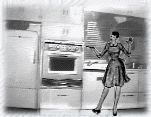 In 1947, Raytheon demonstrated the world's first microwave
oven and called it a "Radarange," the winning name in an
employee contest. Housed in refrigerator-sized cabinets, the first
microwave ovens cost between $2,000 and $3,000. Sometime between 1952-55,
Tappan introduced the first home model priced at $1295. In 1965 Raytheon
acquired Amana Refrigeration. Two years later, the first countertop,
domestic oven was introduced. It was a 100-volt microwave oven, which cost
just under $500 and was smaller, safer and more reliable than previous
models.
In 1947, Raytheon demonstrated the world's first microwave
oven and called it a "Radarange," the winning name in an
employee contest. Housed in refrigerator-sized cabinets, the first
microwave ovens cost between $2,000 and $3,000. Sometime between 1952-55,
Tappan introduced the first home model priced at $1295. In 1965 Raytheon
acquired Amana Refrigeration. Two years later, the first countertop,
domestic oven was introduced. It was a 100-volt microwave oven, which cost
just under $500 and was smaller, safer and more reliable than previous
models.
By 1975 Sales of Microwave Ovens
Exceeded that of Gas Ranges
Technological advances and further developments led
to a microwave oven that was polished and priced for the consumer kitchen.
However, there were many myths and fears surrounding these mysterious new
electronic "radar ranges." By the seventies, more and more
people were finding the benefits of microwave cooking to outweigh the
possible risks, and none of them were dying of radiation poisoning, going
blind, sterile, or becoming impotent (at least not from using microwave
ovens). As fears faded, a swelling wave of acceptance began filtering into
the kitchens of America and other countries. Myths were melting away, and
doubt was turning into demand.
By 1975, sales of microwave ovens
would, for the first time, exceed that of gas ranges. The following year,
a reported 17% of all homes in Japan were doing their cooking by
microwaves, compared with 4% of the homes in the United States the same
year. Before long, though, microwave ovens were adorning the kitchens in
over nine million homes, or about 14%, of all the homes in the United
States. In 1976, the microwave oven became a more commonly owned kitchen
appliance than the dishwasher, reaching nearly 60%, or about 52 million
U.S. households. America's cooking habits were being drastically changed
by the time and energy-saving convenience of the microwave oven. Once
considered a luxury, the microwave oven had developed into a practical
necessity for a fast-paced world.
An expanding market has produced
a style to suit every taste; a size, shape, and color to fit any kitchen,
and a price to please almost every pocketbook. Options and features, such
as the addition of convection heat, probe and sensor cooking, meet the
needs of virtually every cooking, heating or drying application. Today,
the magic of microwave cooking has radiated around the globe, becoming an
international phenomenon.
Inventor Spencer
Doctor Spencer continued at Raytheon
as a senior consultant until he died at the age of 76. At the time of his
death, Dr. Spencer held 150 patents and was considered one of the world's
leading experts in the field of microwave energy, despite his lack of a
high school education.
On September 18, 1999, Dr. Percy LaBaron Spencer was
inducted into the National Inventors Hall of Fame and took his place in
history alongside such great inventors as Thomas Edison, the Wright
Brothers and George Washington Carver.
More to come on the fascinating
history and development of the microwave oven...
Note: Photo of Percy
Spencer and Patent provided courtesy of The Spencer Family Archives
Picture of the earliest microwave oven provided courtesy of The Lemelson-MIT
Awards Program's Invention Dimension web site, http://web.mit.edu/invent

Picture
of Original Microwave Oven Patent by Doctor Percy L. Spencer
Courtesy Rod Spencer and the Spencer Family Archives

Copyright Information
Unless otherwise noted, all
materials at this cite (including without limitation all text, html
markup, graphics, and graphic elements) are copyrighted ©, 1989-2001 by J.
Carlton Gallawa. The material available through this site may be
freely used for attributed noncommercial educational
purposes only. We ask that due credit and notification be given the
author.
|
| Amana Radarange
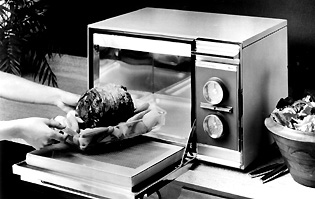 Amana
Refrigeration, a subsidiary of Raytheon Manufacturing Company, in 1967
introduced this first compact microwave oven, called the Radarange. It was
a 115 V countertop model, retailing for $495, and cooked hamburgers in 35
seconds. The compact size was made possible by a small, efficient electron
tube, developed in 1964 by the Japanese, which replaced older, bulkier
tubes called magnetrons. Amana
Refrigeration, a subsidiary of Raytheon Manufacturing Company, in 1967
introduced this first compact microwave oven, called the Radarange. It was
a 115 V countertop model, retailing for $495, and cooked hamburgers in 35
seconds. The compact size was made possible by a small, efficient electron
tube, developed in 1964 by the Japanese, which replaced older, bulkier
tubes called magnetrons.
In 1968, tests by Walter Reed Hospital confirmed many fears that
microwaves did, in fact, leak out of the ovens, but Federal standards set
in 1971 resolved the problem. By 1994, ninety per cent of all US homes had
such an appliance.
The first microwave ovens for home consumer use were introduced by
Tappan in 1955, but few purchased them due to their large size (about like
an electric stove) and high cost.
Microwave ovens were a spin-off of wartime RADAR, and invented
accidentally by Percy LeBaron Spencer of Raytheon while working on a
magnetron (radar tube) near the end of the war. As he passed the device,
which generated microwaves, he noticed that a candy bar in his pocket
began to melt. He experimented with eggs (they exploded) and popcorn (it
popped). So, a "high frequency dielectric heating apparatus" was
patented in 1945 by Raytheon, and a prototype built. The first microwave
oven for commercial purposes (ships and hotels) was introduced in 1947 by
Raytheon, and named the Radar Range. It stood five and a half feet tall,
weighed 750 pounds, and cost $3000
30th Anniversary of Microwave Oven Marks
Revolution in America’s Home Kitchens
Return
to News Index
-
AMANA, Iowa — It’s been 30 years since the first household
microwave oven was introduced to families across America. Hailed as a
technological breakthrough and criticized as a gimmick that would ruin
the fine art of cooking, the Amana Radarange was debuted in Chicago in
1967 as a product that would forever change how Americans eat and
cook.
The microwave oven has come a long way since then. Today, more than
90 percent of America’s households include a microwave oven. And, in
a recent Yankelovich Partners study, Americans ranked the microwave
oven as the No. 1 technology that makes their lives easier, right
ahead of the telephone answering machine and the automatic teller
machine (ATM). According to Dixie Trout, Amana vice president of
consumer communications, many Amana engineers envisioned the microwave
oven replacing the conventional oven.

Introduced in 1967, the Amana Radarange
microwave oven would forever change the
way American families prepare meals.
“It was a time of astronauts, instant Tang orange drink and TV
dinners,” says Trout. “And many appliance manufacturers, such as
Amana, aimed to take the drudgery out of the typical homemaker’s
life and replace it with the modern conveniences of the ‘home of the
future.’ In reality, it was the dawn of the ‘Supermom,’ which
was spurred by the large number of mothers who entered the
workforce.”
“In retrospect,” Trout adds, “while the microwave oven did
not replace the conventional oven entirely, we now have an entire
generation that’s grown up with the microwave oven, and have come to
rely upon it just as much as their PCs and cell phones.”
The first Amana Radarange microwave oven was powered by a 115-volt
current, says Trout, and it featured just two buttons, “start” and
“light.” It also included two control knobs, one for cooking times
up to five minutes, and the other for longer cooking times up to 25
minutes.
Demonstrating just how far microwaves have evolved, today’s Amana
microwave oven line features a unit with 1,000 watts of cooking power
and electronic controls with pre-programmed pads. According to Trout,
it cooks food in half the time, costs 50 percent less, and features a
contemporary, streamlined design compared to the bulky, sterile look
of the original model.
To say the Amana Radarange oven changed the landscape of American
cooking and eating is an understatement. “It sparked a
revolution,” says Marcia Copeland, director of General Mill’s
Betty Crocker Kitchens. “Not only did it allow us to cook food
quickly, it also offered us the opportunity to make food we might not
have because of our busy lifestyles — especially in the area of
snacks, such as microwave popcorn.”
“The microwave also paved the way for new food products that
children could prepare safely,” Copeland adds. “Parents feel
comfortable letting kids prepare after-school snacks or starting
dinner with the microwave.”
“The microwave oven is the No. 1-rated technology in our Monitor
research for making people’s lives better,” says J. Walker Smith,
managing partner, Yankelovich Partners. “It’s moved from giving
people instant gratification to making life easier, which fits
perfectly into the lives people are trying to lead today.”
Smith notes, “Our research shows that nowadays people of all ages
are trying to strike a balance between work and personal activities.
The home has become a sanctuary from life’s stresses. And the
microwave oven is important to this because it makes it possible for
family members to spend less time in the kitchen and more time in the
family room.”
The microwave oven also has dramatically modified kitchen design,
adds Ann Steiner, who writes a nationally syndicated column on
microwave cooking with CiCi Williamson. “When it was first
introduced, the microwave oven was considered a gimmick. Today, it’s
as essential as the kitchen sink. It’s no longer resting on the
counter — many people purposely plan their kitchen remodeling
projects around the microwave oven.”
Beyond the confines of the home kitchen, the microwave oven’s
impact has been felt in a number of other ways. For example, the fast
food and food service industry heavily rely on microwave ovens to meet
the demands for quality food served fast.
“At Amana, we pride ourselves on developing high quality,
innovative products,” says Trout, “but no one here in 1967 could
have imagined the enormous impact the Radarange has had on American
society. Who knows what awaits the microwave technology in the years
to come.”
Capturing the Public’s Attention, Interest
Amana introduced the world’s first 115-volt countertop microwave
oven in 1967. Geared specifically for consumer use, the product sold
for $495 retail.
Because microwave oven technology was so unconventional, Amana
executives sensed that the new product didn’t stand a chance in the
marketplace without a massive effort to educate appliance retailers
and consumers.
After a year-long effort of educating wholesalers and retailers,
Amana launched the Radarange with a massive, nationwide media blitz
that kicked off in Chicago. Amana invited reporters and homemakers to
tour the city’s suburbs, while Amana hosts served coffee, reheated
meals and made popcorn.
In addition, a specially trained home economist arrived at the
homes of Chicago homemakers to help them install their Amana Radarange
and cook the family’s first microwave meal. She was on 24-hour call
for each of her clients for the first year of the launch. A serviceman
also was on call, guaranteed to show up within an hour, if there were
any problems.
The campaign was a success and the age of microwave cooking was
launched. Throughout the 1970s, Amana continued to improve the
microwave oven, adding new features, and improving the microwave’s
cooking capabilities.
Today, Amana markets a variety of microwave ovens with up to 1,000
watts of cooking power and a wide array of conveniences. Portable,
efficient, safe and economical, few gourmet or fast food cooks of the
1990’s can imagine life without a microwave oven.
For more information on Amana appliances or to locate your nearest
dealer, contact Amana at 1-800-843-0304. Or, check out the Amana web
site at www.amana.com for additional product and service information.
(ARA)
Founded in 1934 in Amana, Iowa, Amana Home Appliances offers
a complete line of products that generations have come to trust for
their timeless design, craftsmanship, performance and innovation.
Amana appliances, which include refrigerators, freezers, ranges, wall
ovens, cooktops, Radarange® microwave ovens, dishwashers, washers and
dryers, room air conditioners and dehumidifiers, are sold by major
retailers and independent appliance dealers across the United States.
Editor’s note: Interviews with Dixie Trout, Amana vice
president of consumer communications, are available by contacting
Stephen Dupont, Carmichael Lynch Spong, 612/334-6235, or by e-mail at
sdupont@clynch.com.
Courtesy of Article Resource Association, www.aracopy.com.
Happy
Birthday, Amana
By
Norman Remich

Having
debuted in 1967 in Chicago "as a product that would forever
change how Americans eat and cook," the Amana Radarange is
celebrating its 35th birthday. |
The Amana
Radarange is celebrating its 35th birthday. It debuted in 1967 in
Chicago “as a product that would forever change how Americans
eat and cook.”
Today, more than 95 percent of American households own a
micro-wave oven, and 75 percent of those surveyed by a recent
Yankelovich Monitor study ranked the microwave oven as “almost
impossible/pretty difficult” to do without. Only the automobile
ranks higher.
The first Radarange featured a 115-volt current and just two
buttons, start and light (on/off). It also included two control
knobs, one for cooking times up to five minutes, and the other for
longer cooking times up to 25 minutes.
Thirty-five years later, the Classic Radarange features 1,100
watts of power, 11 variable Cookmatic power levels, eight
changeable preset Auto-cook options, and two changeable favorite
message pads.
The Convection Radarange, the latest model (shown), provides
1,000 watts of power, a stainless-steel interior, Touchmatic
Control System, four convection cooking options, and nine sensor
cook options.
Amana is a unit of Maytag Corp., Newton, Iowa.
|
Norman
is AM's executive editor.
http://www.ammagazine.com/CDA/ArticleInformation/features/BNP__Features__Item/0,2606,78114,00.html |
|
 Learn about Winfield
Salisbury in the late 40's and the Microwave Oven At Iowa State Fair
Learn about Winfield
Salisbury in the late 40's and the Microwave Oven At Iowa State Fair |
|
|
|
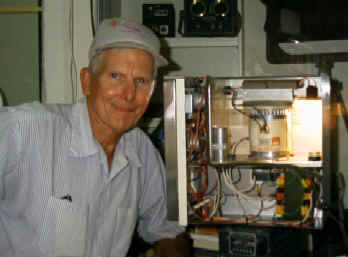
Engineer
Bob Snyder With the Microwave
Oven 'Works' Display he built for the museum.
|
|
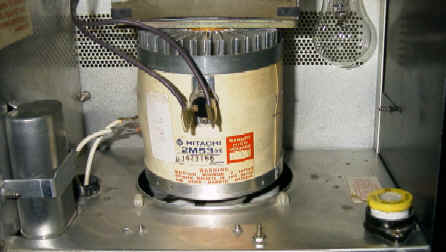
Close up of the Magnetron used in the
oven assembly on display. |
|
An interesting Link on questions and answers about
microwave ovens can be found at: "How Things Work:
Microwave Ovens," Louis A. Bloomfield, http://landau1.phys.virginia.edu/Education/Teaching/HowThingsWork/microwave_ovens.html
|
|
Below is a company that has many parts when you are
working on your kitchens microwave oven:
|
| Whether you’re an experienced do-it-yourselfer or just handy to have around the home, appliance repair has never been easier than with appliance parts from PartSelect. We offer a huge inventory of ready-to-order appliance parts plus access to our free repair forum to help guide you through you’re appliance repair.
We have an extensive inventory of appliance parts for most major household brands, like Jenn-Air parts for your favorite cooktop or range. We take pride in providing quality parts to each and every customer so when you order your GE appliance parts, you can feel confident that you’re getting a factory authorized part, backed with a one-year warranty. At PartSelect, we know it’s a hassle when an appliance breaks and that’s why we also offer time saving features like same day shipping available on all in stock parts. It doesn’t matter if you need a major Kitchen Aid part shipped fast over night, or you’re just looking to give your older Maytag appliance an updated look, PartSelect has everything you need.
You can order online at PartSelect.com, or call our toll free number at 1-888-895-1535 for assistance from a customer service representative. Get your appliance repaired quick and easy with appliance parts from PartSelect
|
|
|
|
 Learn about Winfield
Salisbury in the late 40's and the Microwave Oven At Iowa State Fair
Learn about Winfield
Salisbury in the late 40's and the Microwave Oven At Iowa State Fair
 Like
many of today's great inventions, the microwave oven was a by-product of
another technology. It was during a radar-related
Like
many of today's great inventions, the microwave oven was a by-product of
another technology. It was during a radar-related  research
project around 1946 that Dr. Percy Spencer, a self-taught engineer with
the Raytheon Corporation, noticed something very unusual. He was testing a
new vacuum tube called a
research
project around 1946 that Dr. Percy Spencer, a self-taught engineer with
the Raytheon Corporation, noticed something very unusual. He was testing a
new vacuum tube called a  to
put the magnetron tube near an egg. Spencer was joined by a curious
colleague, and they both watched as the egg began to tremor and quake. The
rapid temperature rise within the egg was causing tremendous internal
pressure. Evidently the curious colleague moved in for a closer look just
as the egg exploded and splattered hot yoke all over his amazed face. The
face of Spencer lit up with a logical scientific conclusion: the melted
candy bar, the popcorn, and now the exploding egg, were all attributable
to exposure to low-density microwave energy. Thus, if an egg can be cooked
that quickly, why not other foods? Experimentation began...
to
put the magnetron tube near an egg. Spencer was joined by a curious
colleague, and they both watched as the egg began to tremor and quake. The
rapid temperature rise within the egg was causing tremendous internal
pressure. Evidently the curious colleague moved in for a closer look just
as the egg exploded and splattered hot yoke all over his amazed face. The
face of Spencer lit up with a logical scientific conclusion: the melted
candy bar, the popcorn, and now the exploding egg, were all attributable
to exposure to low-density microwave energy. Thus, if an egg can be cooked
that quickly, why not other foods? Experimentation began...
 hese
primitive units where gigantic and enormously expensive, standing 5 1/2
feet tall, weighing over 750 pounds, and costing about $5000 each. The
magnetron tube had to be water-cooled, so plumbing installations were also
required.
hese
primitive units where gigantic and enormously expensive, standing 5 1/2
feet tall, weighing over 750 pounds, and costing about $5000 each. The
magnetron tube had to be water-cooled, so plumbing installations were also
required.
 In 1947, Raytheon demonstrated the world's first microwave
oven and called it a "Radarange," the winning name in an
employee contest. Housed in refrigerator-sized cabinets, the first
microwave ovens cost between $2,000 and $3,000. Sometime between 1952-55,
Tappan introduced the first home model priced at $1295. In 1965 Raytheon
acquired Amana Refrigeration. Two years later, the first countertop,
domestic oven was introduced. It was a 100-volt microwave oven, which cost
just under $500 and was smaller, safer and more reliable than previous
models.
In 1947, Raytheon demonstrated the world's first microwave
oven and called it a "Radarange," the winning name in an
employee contest. Housed in refrigerator-sized cabinets, the first
microwave ovens cost between $2,000 and $3,000. Sometime between 1952-55,
Tappan introduced the first home model priced at $1295. In 1965 Raytheon
acquired Amana Refrigeration. Two years later, the first countertop,
domestic oven was introduced. It was a 100-volt microwave oven, which cost
just under $500 and was smaller, safer and more reliable than previous
models.

 Amana
Refrigeration, a subsidiary of Raytheon Manufacturing Company, in 1967
introduced this first compact microwave oven, called the Radarange. It was
a 115 V countertop model, retailing for $495, and cooked hamburgers in 35
seconds. The compact size was made possible by a small, efficient electron
tube, developed in 1964 by the Japanese, which replaced older, bulkier
tubes called magnetrons.
Amana
Refrigeration, a subsidiary of Raytheon Manufacturing Company, in 1967
introduced this first compact microwave oven, called the Radarange. It was
a 115 V countertop model, retailing for $495, and cooked hamburgers in 35
seconds. The compact size was made possible by a small, efficient electron
tube, developed in 1964 by the Japanese, which replaced older, bulkier
tubes called magnetrons.




